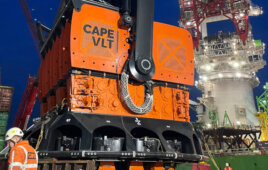
Should something go wrong with a primary system during training, the DEUS 7300T, a backup belay, instantaneously engages when it senses an over-speed situation and continues descent to the ground at a safe speed.
A recent safety device provides a hands-free, training-neutral, back-up belay that is easy, safe, and automatic. The NFPA-certified Deus 7300T Training Back-up Belay System helps create realistic bailout, evacuation, and rescue training experiences, while maintaining maximum safety for trainees.
Intended for use in training, the device instantly produces a “soft engagement” when a descent speed exceeds 3 m/s. The device helps guard against free fall while still preventing shock load and injury. And because the system operates automatically, chances of operator error are reduced or eliminated.
By contrast, back-up belay systems activated when the person running the belay sees a problem may fail if something distracts the belay operator, and will fail if the belay operator’s reactions are not extremely fast. The Deus 7300T eliminates both problems. “Training experiences must be as realistic as possible so trainees know how to handle stressful situations,” says Deus Rescue president James Fay. “Training for real life involved some risk with old belay training devices. The person on a belay might not have reacted swiftly enough to prevent free fall, or might have created a sudden shock load on the safety line that could have caused injuries. The device helps avoid many training dangers.”
With the device as a back-up belay system, when something goes wrong with the primary system during training – say an anchor doesn’t hold, operator error, or in bailout system failure – the Deus 7300T instantaneously engages when it senses over-speed and continues descent to the ground at a safe speed. Many other back-up belays lock-up and shock load the student, which risks injury and stops training until a rescue can be performed.
By keeping an 11 mm Deus Training Belay rope active at all times, the unit lets trainees experiment with and perfect standard operating procedures in a setting that mimics the real world. The device produces minimal interference with the training experience. Trainers appreciate the added safety for trainees and the system speed. Rope reversibly runs through the belay device without re-rigging, which makes back-to-back evolutions fast and easy. Trainers can rig the flexible system several ways depending on training goals. Rigged to a high anchor, the device supports multiple sequential descents without re-rigging. A ground anchor lets users run the belay line through a high-anchor pulley to control descent by the rope free end.
“This is about creating a safe, efficient training program that lets trainees experience a real descent as safely as possible,” says Fay. “Good training means a better chance of performing rescues quickly and safely in the real world as well.”
Deus Rescue
www.deusrescue.com
Filed Under: News, Safety




